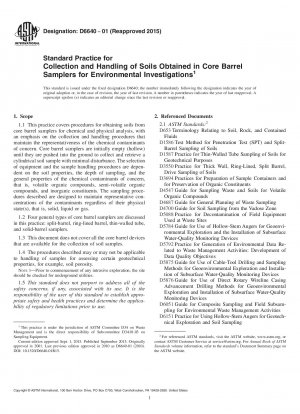ASTM D6640-01(2015)
Standard Practice for Collection and Handling of Soils Obtained in Core Barrel Samplers for Environmental Investigations
- Standard No.
- ASTM D6640-01(2015)
- Release Date
- 2001
- Published By
- American Society for Testing and Materials (ASTM)
- Status
- Replace By
- ASTM D6640-21
- Latest
- ASTM D6640-21
- Scope
4.1 Often during environmental investigations, soils are analyzed after being collected from the surface, the vadose zone (Terminology D653) and sometimes from below the ground water table to identify and quantify the presence of a chemical contaminant. A contaminant is a substance that is typically hazardous and either is not normally present or that occurs naturally but is of an uncharacteristically high concentration (Guide D4687). A three-dimensional spatial array of samples can often provide information as to the source and route(s) of migration of the contaminant. The resultant information is used to direct remedial and corrective actions or can be used for monitoring purposes. Obtaining a soil sample with a core barrel sampler involves driving this device into the ground and then retrieving it for sample processing. Several methods for advancing a core barrel are generally acceptable (for example, Test Method D1586, Practice D1587, Practice D3550, Guide D4700, Guide D5784, Guide D5875, Guide D5876, Practice D6151, Guide D6282, and Guide D6286). Drilling methods that use drilling fluids (liquids or air) should be avoided because they are more susceptible to cross-contamination (See 5.1.6).
1.1 This practice covers procedures for obtaining soils from core barrel samplers for chemical and physical analysis, with an emphasis on the collection and handling procedures that maintain the representativeness of the chemical contaminants of concern. Core barrel samplers are initially empty (hollow) until they are pushed into the ground to collect and retrieve a cylindrical soil sample with minimal disturbance. The selection of equipment and the sample handling procedures are dependent on the soil properties, the depth of sampling, and the general properties of the chemical contaminants of concern, that is, volatile organic compounds, semi-volatile organic compounds, and inorganic constituents. The sampling procedures described are designed to maintain representative concentrations of the contaminants regardless of their physical state(s), that is, solid, liquid or gas.
1.2 Four general types of core barrel samplers are discussed in this practice: split-barrel, ring-lined barrel, thin-walled tube, and solid-barrel samplers.
1.3 This document does not cover all the core barrel devices that are available for the collection of soil samples.
1.4 The procedures described may or may not be applicable to handling of samples for assessing certain geotechnical properties, for example, soil porosity.
Note 1: Prior to commencement of any intrusive exploration, the site should be checked for underground utilities.
1.5 This standard does not purport to address all of the safety concerns, if any, ......
ASTM D6640-01(2015) Referenced Document
- ASTM D1586 Standard Test Method for Penetration Test and Split-Barrel Sampling of Soils
- ASTM D1587 Standard Practice for Thin-Walled Tube Sampling of Soils for Geotechnical Purposes*, 2024-04-20 Update
- ASTM D3550 Standard Practice for Thick Wall, Ring-Lined, Split Barrel, Drive Sampling of Soils
- ASTM D3694 Standard Practices for Preparation of Sample Containers and for Preservation of Organic Constituents
- ASTM D4547 Standard Guide for Sampling Waste and Soils for Volatile Organic Compounds
- ASTM D4687 Standard Guide for General Planning of Waste Sampling
- ASTM D4700 Standard Guide for Soil Sampling from the Vadose Zone
- ASTM D5088 Standard Practice for Decontamination of Field Equipment Used at Nonradioactive Waste Sites
- ASTM D5784 Standard Guide for Use of Hollow-Stem Augers for Geoenvironmental Exploration and the Installation of Subsurface Water-Quality Monitoring Devices
- ASTM D5792 Standard Practice for Generation of Environmental Data Related to Waste Management Activities: Development of Data Quality Objectives
- ASTM D5875 Standard Guide for Use of Cable-Tool Drilling and Sampling Methods for Geoenvironmental Exploration and Installation of Subsurface Water-Quality Monitoring Devices
- ASTM D5876 Standard Guide for Use of Direct Rotary Wireline Casing Advancement Drilling Methods for Geoenvironmental Exploration and Installation of Subsurface Water-Quality Monitoring Devices
- ASTM D6051 Standard Guide for Composite Sampling and Field Subsampling for Environmental Waste Management Activities
- ASTM D6151 Standard Practice for Using Hollow-Stem Augers for Geotechnical Exploration and Soil Sampling
- ASTM D6169 Standard Guide for Selection of Soil and Rock Sampling Devices Used With Drill Rigs for Environmental Investigations
- ASTM D6232 Standard Guide for Selection of Sampling Equipment for Waste and Contaminated Media Data Collection Activities
- ASTM D6282 Standard Guide for Direct Push Soil Sampling for Environmental Site Characterizations
- ASTM D6286 Standard Guide for Selection of Drilling Methods for Environmental Site Characterization
- ASTM D653 Standard Terminology Relating to Soil, Rock, and Contained Fluids
ASTM D6640-01(2015) history
- 2021 ASTM D6640-21 Standard Practice for Collection and Handling of Soils Obtained in Core Barrel Samplers for Environmental Investigations
- 2001 ASTM D6640-01(2015) Standard Practice for Collection and Handling of Soils Obtained in Core Barrel Samplers for Environmental Investigations
- 2001 ASTM D6640-01(2010) Standard Practice for Collection and Handling of Soils Obtained in Core Barrel Samplers for Environmental Investigations
- 2001 ASTM D6640-01(2005) Standard Practice for Collection and Handling of Soils Obtained in Core Barrel Samplers for Environmental Investigations
- 2001 ASTM D6640-01 Standard Practice for Collection and Handling of Soils Obtained in Core Barrel Samplers for Environmental Investigations

Copyright ©2024 All Rights Reserved